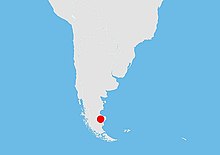Araucarites sanctaecrucis
Araucarites sanctaecrucis is an extinct coniferous tree from Patagonia, Argentina. Its exact affinities are unknown and it is currently assigned to the form genus Araucarites of the family Araucariaceae. A. sanctaecrucis are known from petrified fossils of branches, foliage, and cones from the Cerro Cuadrado Petrified Forest.
| Araucarites sanctaecrucis | |
|---|---|
| Scientific classification | |
| Kingdom: | Plantae |
| Clade: | Tracheophytes |
| Clade: | Gymnosperms |
| Division: | Pinophyta |
| Class: | Pinopsida |
| Order: | Araucariales |
| Family: | Araucariaceae |
| Genus: | †Araucarites |
| Species: | †A. sanctaecrucis |
| Binomial name | |
| †Araucarites sanctaecrucis | |
 | |
| Location of the Cerro Cuadrado Petrified Forest in Patagonia, Argentina | |
| Synonyms[1] | |
| |
Description
The branches of A. sanctaecrucis were woody and symmetrical, approximately 5 to 25 mm (0.20 to 0.98 in) in diameter. Axillary branches are sometimes present in single or double rows at the sides. One side of the recovered detached branches are almost always severely weathered. This is believed to have been the surface facing upwards as it laid on the forest floor.[1]
The leaves were evergreen and arranged spirally. They were flattened against each other (appressed) and scale-like (imbricate). They were rhomboidal in shape, 8 to 14 mm (0.31 to 0.55 in) long and 4 to 8 mm (0.16 to 0.31 in) at its widest. They tapered gradually into a distal subacute point. The undersides of the leaves (abaxial surface) sometimes exhibited parallel longitudinal ridges and grooves. The free part of the lamina (the leaf blade) was about half the length of the leaves.[1]
These fossils are found together with two types of highly distinctive cones (presumed to be female) that show affinities to both Araucariaceae and Cupressaceae (cypresses). However, they have not been described.[1]
Taxonomy
A. sanctaecrucis is classified in the genus Araucarites of the family Araucariaceae. The genus is a form taxon, and is reserved for specimens of possible members of the genus Araucaria, but due to various reasons can not be identified with much confidence. They were described by the Scottish paleobotanist Mary Gordon Calder in 1953.[1]
The genus name, like that of Araucaria, is derived from the Spanish exonym Araucanos ("from Arauco"), referring to the Mapuche people of Chile and Argentina who live in the surviving forests of Araucaria today.[2] The specific name is a Latinized form of "Santa Cruz", the Argentinean province from which the Cerro Cuadrado Petrified Forest is found.
Paleoecology
The dominant species of the forests A. sanctaecrucis are found is Araucaria mirabilis. Pararaucaria patagonica, another conifer, is also found in the area.[3]
Distribution and geologic time range
The Cerro Cuadrado Petrified Forest is part of the La Matilde Formation, dated to the Bathonian to Oxfordian ages (164.7 to 155.7 million years ago) of the Middle to Upper Jurassic.[4][5] The area was once part of the subtropical and temperate regions of the southern supercontinent Gondwana in the Mesozoic era, a more or less continuous landmass consisting of what is now modern South America, Africa, Antarctica, Australia, New Zealand, and New Guinea.[6][7]
References
- Mary Gordon Calder (1953). "A coniferous petrified forest in Patagonia". Bulletin of the British Museum (Natural History), Geology. 2 (2): 97–138.
- Christopher J. Earle (December 12, 2010). "Araucaria Jussieu 1789". The Gymnosperm Database. Retrieved November 13, 2011.
- Ruth A. Stockey; T.N. Taylor (1978). "On the structure and evolutionary relationships of the Cerro Cuadrado fossil conifer seedlings" (PDF). Botanical Journal of the Linnean Society. 76 (2): 161–176. doi:10.1111/j.1095-8339.1978.tb01504.x.
- Alan Channing; Alba B. Zamuner; Adolfo Zúñiga (2007). "A new Middle–Late Jurassic flora and hot spring chert deposit from the Deseado Massif, Santa Cruz province, Argentina" (PDF). Geological Magazine. 144 (2): 401–411. doi:10.1017/S0016756807003263.
- John T. Clarke; Rachel C. M.Warnock; Philip C. J. Donoghue (2011). "Establishing a time-scale for plant evolution" (PDF). New Phytologist. 192 (2011): 266–301. doi:10.1111/j.1469-8137.2011.03794.x. PMID 21729086.
- Andrea S. Sequeira; Benjamin B. Normark; Brian D. Farrell (2000). "Evolutionary assembly of the conifer fauna: distinguishing ancient from recent associations in bark beetles". Proceedings of the Royal Society. B. 267 (1460): 2359–2366. doi:10.1098/rspb.2000.1292. PMC 1690824. PMID 11133024.
- Ari Iglesias; Analia E. Artabe; Eduardo M. Morel (2011). "The evolution of Patagonian climate and vegetation from the Mesozoic to the present". Biological Journal of the Linnean Society. 103 (2): 409–422. doi:10.1111/j.1095-8312.2011.01657.x.